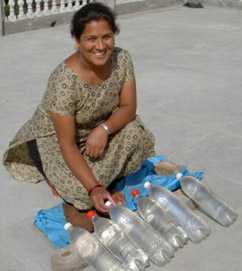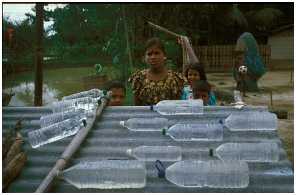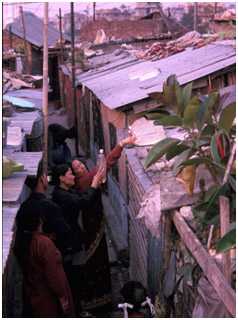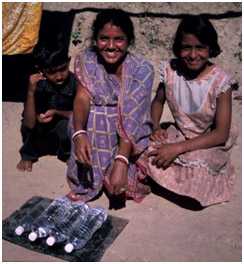Solar Disinfection

A woman using SODIS (Swiss Federal Institute)
Solar Disinfection [PDF – 2 pages]
Solar disinfection (SODIS) was developed in the 1980s to inexpensively disinfect water used for oral rehydration solutions. In 1991, the Swiss Federal Institute for Environmental Science and Technology began to investigate and implement SODIS as a household water treatment option to prevent diarrhea in developing countries. Users of SODIS fill 0.3-2.0 liter plastic soda bottles with low-turbidity water, shake them to oxygenate, and place the bottles on a roof or rack for 6 hours (if sunny) or 2 days (if cloudy). The combined effects of ultra-violet light (UV)-induced DNA damage, thermal inactivation, and photo-oxidative destruction inactivate disease-causing organisms.
Lab Effectiveness, Field Effectiveness, and Health Impact
In the laboratory, SODIS has been proven to inactivate the viruses, bacteria, and protozoa that cause diarrheal diseases. Field data have also shown reductions of viruses, bacteria, and protozoa in water from developing countries treated with SODIS. In four randomized, controlled trials, SODIS has resulted in reductions in diarrheal disease incidence ranging from 9-86%.
Benefits, Drawbacks, and Appropriateness

Using SODIS on a rooftop (Swiss Federal Institute)
The benefits of Solar Disinfection are:
- Proven reduction of viruses, bacteria, and protozoa in water
- Proven reduction of diarrheal disease incidence
- Simplicity of use and acceptability
- No cost if using recycled plastic bottles
- Minimal change in taste of the water
- Recontamination is low because water is served and stored in the small narrow necked bottles
The drawbacks of Solar Disinfection are:
- Need to pretreat water of higher turbidity with flocculation and/or filtration
- Limited volume of water that can be treated all at once
- Length of time required to treat water
- Large supply of intact, clean, suitable plastic bottles required
SODIS is most appropriate in areas where there is availability of bottles and community motivation and training for users on how to correctly and consistently use SODIS for treating household drinking water.
Implementation Examples

Using SODIS on a rooftop (Swiss Federal Institute)
Over 2 million people in 28 developing countries use SODIS for daily drinking water treatment.
Experience has shown that SODIS is best promoted and disseminated by partner institutions based in the project area. Important partners are community-based organizations (CBOs) such as women’s clubs, youth associations or self-help groups, well-established NGOs working on community development projects, institutional organizations such as health posts, hospitals, and teacher training centers, and government programs. Individuals, such as community and religious leaders as well as politicians and decision-makers, play a key role and should be involved from the beginning of a project. SODIS promotion in a new area usually begins with a pilot project of one year that reaches 2000-4000 families. In the second year, the project expands into the field of advocacy to scale-up the project.
The CBO Kenya Water for Health Organisation promotes SODIS in the Kibera slums of Nairobi, Kenya. Over 250,000 people are reached by trained promoters using social marketing to disseminate knowledge about SODIS. Research-based information is given out by promoters to potential users, especially when users are skeptical about SODIS.
In Latin America the promotion is channeled through a regional reference center, Fundaçion Sodis. Their strategy is to build and strengthen a network of partner institutions; they do not implement projects, but focuses on training trainers, technical assistance, and lobbying activities. More than 100,000 people are using SODIS in Latin America.
In Assam, India, Assam University provided technical and training support for a SODIS promotion project with a local NGO. The dissemination phase targeted 20,000 households based on lessons learned during the pilot phase. An approach involving active participation of institutions such as village councils, schools, and health centers was adopted to ensure the project is community-owned and sustainable.
Economics and Scalability

Children with SODIS (Swiss Federal Institute)
SODIS, as a virtually zero-cost technology, faces marketing constraints. Since 2001, local NGOs in 28 countries have disseminated SODIS through training of trainers, educating at the grassroots level, providing technical assistance to partner organizations, lobbying key players, and establishing information networks. The experiences gained have shown that SODIS is best promoted and disseminated by local institutions with experience in community health education. A long-term training approach and repeated contact with the community is needed to create awareness on the importance of treating drinking water and to establish corresponding changes in behavior. Both the Swiss Federal Institute of Aquatic Research and Technology and the SODIS Foundation provide technical assistance to NGOs implementing SODIS.
Additional Resources
For more information about solar disinfection for developing countries visit:
- Page last reviewed: October 10, 2012
- Page last updated: May 2, 2014
- Content Source:


 ShareCompartir
ShareCompartir